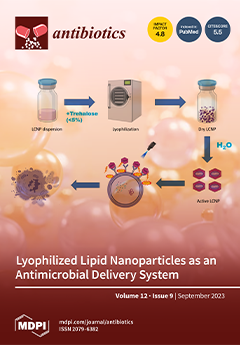Tanacetum annuum L. is a Mediterranean plant, commonly known as Blue Tansy due to its blue colour as an essential oil, which is widely used for medicinal purposes. However, there are no studies on the bioactive compounds (especially, phenolic compounds) and the biological
[...] Read more.
Tanacetum annuum L. is a Mediterranean plant, commonly known as Blue Tansy due to its blue colour as an essential oil, which is widely used for medicinal purposes. However, there are no studies on the bioactive compounds (especially, phenolic compounds) and the biological properties of their organic extracts. Herein, the purpose of the present work was to investigate the chemical composition of the essential oil and crude extracts of the
T. annuum aerial parts collected from northern Morocco and to evaluate their antioxidant and antifungal activity against
Fusarium oxysporum f. sp.
albedinis, an agent causing Bayoud disease of the date palm, an important food source and commercial perennial crop in the Sahara and North Africa. Chemically, Folin–Ciocalteu and aluminium chloride colourimetric methods were used to determine the total phenolic (TPC) and total flavonoid (TFC) contents, respectively; polyphenols were characterized using HPLC-MS, while GC-MS was used to analyse the essential oil composition. Moreover, the evaluation of antioxidant and antifungal activities was carried out using the DPPH test and microdilution method, respectively. The results showed that the three
T. annuum parts (stems, leaves and flowers) extracts contained important TPC and TFC with values varied between 51.32 and 116.32 mg/g of dry crude extract (DCE). HPLC-MS analysis revealed the identification and quantification of 19 phenolic acids and flavonoids with an emphasis on apigenin 7-glucoside (4540 µg/g of dry weight (DW)), luteolin 7-glucoside (2804 µg/g DW) and salicylic acid (1878 µg/g DW). Additionally, 39 biomolecules were identified in the essential oil using GC-MS, which were predominated by camphor (16.69%), α-pinene (12.37%), bornyl acetate (11.97%) and limonene (11.10%). The methanolic and hydro-methanolic extracts of
T. annuum parts demonstrated a strong antioxidant property with IC
50 values ranging between 0.22 and 0.65 mg/mL. Concerning antifungal activity, the essential oil and crude extracts of the Moroccan Blue Tansy exhibited a potent capacity against
F. oxysporum f. sp.
albedinis at low concentrations, with MIC and MFC values of 3.33 and 4.58 µL/mL for the essential oil and values of 3.33 and 9.17 mg/mL for crude extracts, respectively. Overall, these results demonstrated
T. annuum as an important source of bioactive compounds and contribute significantly to the potential of using essential oils and extracts for controlling the Bayoud disease of date palms. Moreover, the finding suggests that
T. annuum can be highly useful for phytosanitary and pharmaceutical industries.
Full article






